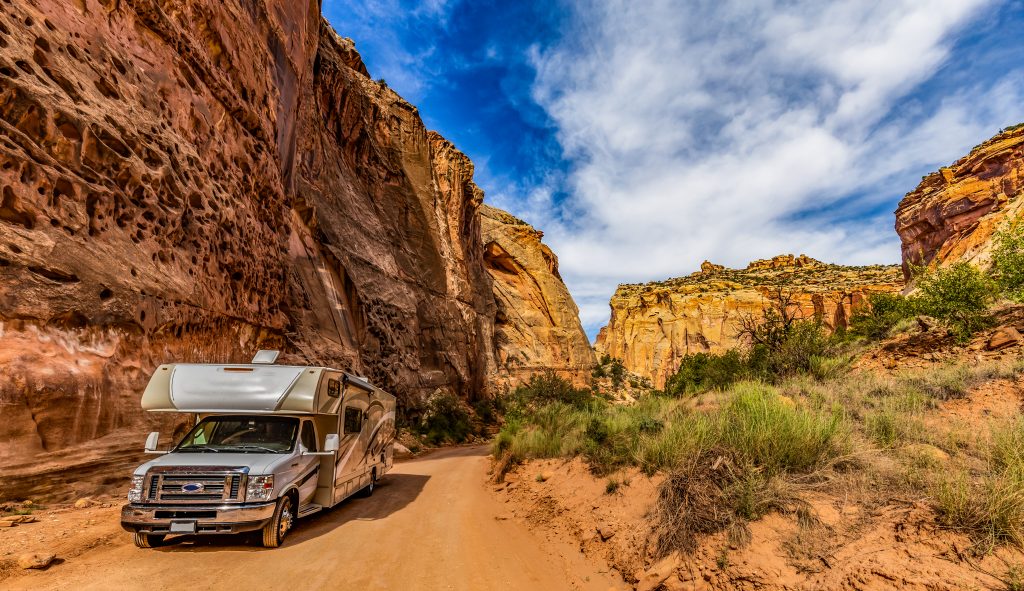
Some of our country’s most spectacular camping spots are in Utah.
Whether you want to experience the wonders of red rock country, the many activities in the mountains, or the sparkling shores of the Great Salt Lake, you’ll find there is a little something for everyone here.
When is the best time to go camping in Utah?
There are activities to enjoy year-round in Utah. In the warm spring and summer months, you can hike miles of trails through red rock country or go canyoneering through slot canyons. By winter, the mountains provide a wonderland for activities like skiing, snowboarding, and snowshoeing.
Spring is the perfect time to go camping in Utah, when the temperatures are more comfortable, there are fewer crowds than in the summer, and the wildflowers are blooming.
Driving in Utah
Utah has some of the most scenic roads in the country, but not all routes are suitable for RVs. Make sure you have an RV-safe GPS to get turn-by-turn directions based on your vehicle’s specifications. Current weather and traffic conditions are regularly updated on the UDOT website.
Some of the major highways in Utah include:
- Interstate 15 runs north-south all the way through Western Utah. The I-15 corridor connects most of the state’s major cities including Salt Lake City, Ogden, Provo, and St. George.
- Interstate 70 branches off I-15 in the western half of the state, near the Cove Fort Historic Site, and leads all the way to Maryland on the East Coast.
- Interstate 80 spans east-west through Northern Utah. It runs through Salt Lake City, over the Wasatch Mountains, and then northeast into Wyoming.
- U.S. Route 6 runs east-west through Central Utah. Stretches of the route are concurrent with the other major highways including I-15, I-70, and US-50.
- U.S. Route 191 runs north-south all the way through Eastern Utah. It passes through the town of Moab and serves as the gateway to Arches National Park and Canyonlands.
- U.S. Route 89 spans north-south through Central Utah’s Wasatch Mountains. The route runs all the way south to Flagstaff, AZ, and north to Yellowstone.
Scenic drives in Utah
Although many roads in Utah provide beautiful views, there are quite a few routes that are specifically designated as Scenic Byways. However, not all of these routes are RV-friendly, so using an RV-safe GPS like the RV LIFE App is essential for safe travels.
Some of the Scenic Byways in Utah include:
Zion-Mt. Carmel Scenic Highway
This scenic route twists and turns through the towering cliffs in Zion National Park. It follows up a series of switchbacks and through a tunnel built right into the rock cliff. Keep in mind the road has a vehicle length limit of 40 feet (or 50 feet for vehicle combinations) and is not suitable for large RVs.
Scenic Byway 12
Scenic Byway 12 is a designated All-American Road that connects Bryce Canyon and Capitol Reef National Park. The byway leads over Boulder Mountain Pass and through Red Canyon tunnels.
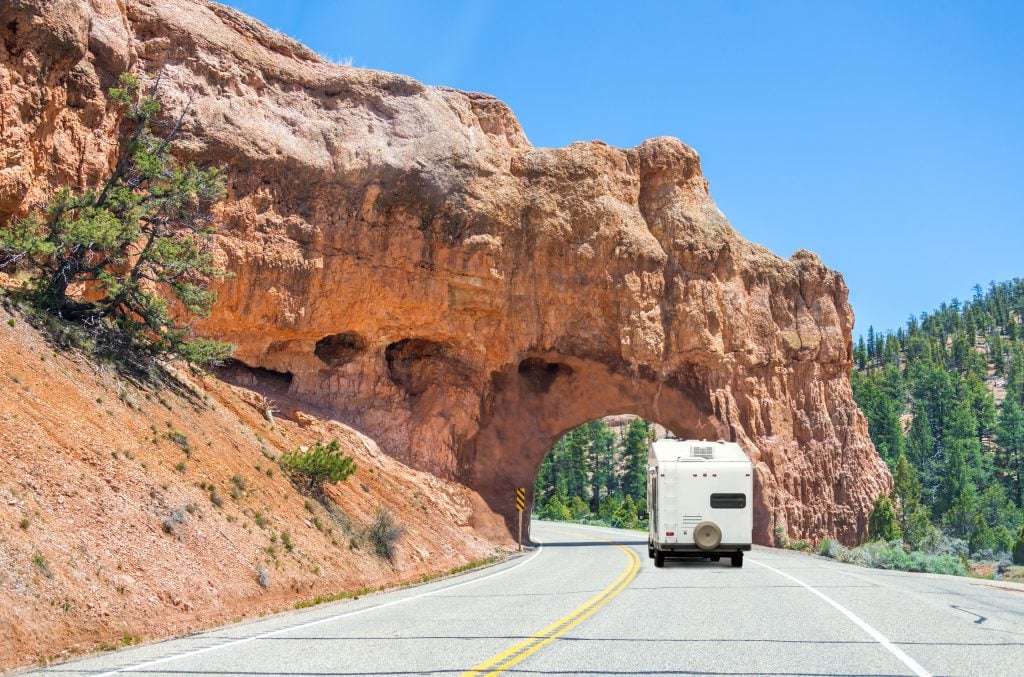
- Scenic drive in Utah – Photo via Shutterstock Standard License
Scenic Byway 24
This scenic stretch of US Route 24 runs through Capitol Reef National Park. The route begins in Torrey, UT, and heads east through the park, passing by the visitor center. It continues through a remote area before reaching the small town of Hanksville, and then follows north to connect with I-70.
Mt. Carmel to Long Valley Scenic Byway
This byway follows a beautiful stretch of US-89 for about 60 miles. It begins in the town of Kanab and leads north toward Mt. Carmel Junction. Several roads branch off the byway and provide access to Grand Staircase National Monument. The road winds through red rock canyons and a forested mountain landscape until it comes to an end at the US-89 and US-12 junction.
Logan Canyon Scenic Byway
If you’re camping in Utah during the fall, the Logan Canyon Scenic Byway is the perfect route to take to see the seasonal foliage. The route runs east-west on US-89 from Logan, UT, to Garden City on Bear Lake. This area provides access to all kinds of outdoor activities like hiking, camping, fishing, and skiing.
National Parks in Utah
Utah is best known for its “Mighty 5” National Parks. The parks are all within a relatively short drive of one another and some can be connected via the scenic byways listed above.
If you plan on visiting them all, it is highly recommended to purchase an America The Beautiful Pass ahead of time. This annual pass is $80 and good for the entire year. Considering the entrance fee to these national parks are $35 for each location, the annual pass pays for itself after visiting just 3 parks.
Zion National Park
Zion is the westernmost national park in Utah, located about 2.5–3 hours east of Las Vegas. The landscape is dominated by giant sandstone cliffs and slot canyons, providing plenty of opportunities for outdoor adventures. Hike the park’s scenic trails, such as the famous Angels Landing; go climbing or canyoneering in the slot canyons; or enjoy tubing on the Virgin River.
There are 3 campgrounds in Zion National Park including South Campground and Watchman Campground. There are also several campgrounds and RV parks within a short drive of the park.
Bordering the eastern entrance to the park is Zion Ponderosa Ranch Resort. This vast, 4,000-acre ranch offers spacious RV sites, a variety of glamping accommodations such as cabins, yurts, and Conestoga wagons, as well as on-site activities available through East Zion Adventures.
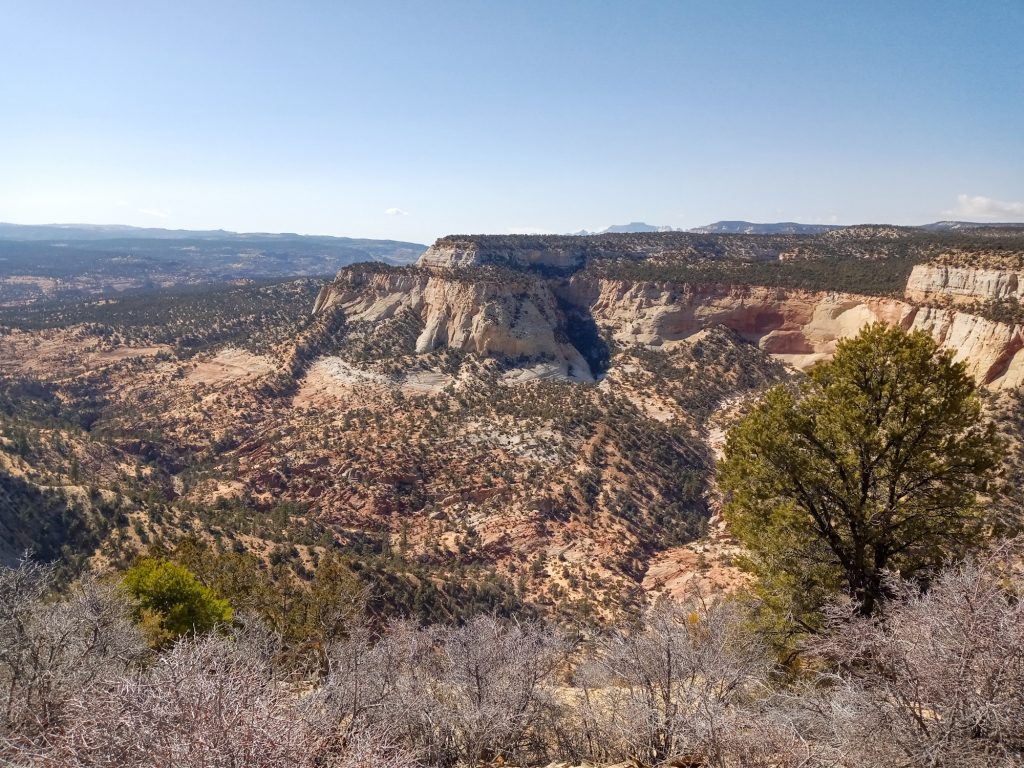
- Views of Zion. Photo by author (Nikki Cleveland)
Bryce Canyon National Park
Bryce Canyon, less than 2 hours east of Zion, is well known for its massive hoodoos and spires. At 9,100 feet in elevation, Bryce Canyon is nearly double that of Zion (at just 4,000 feet). The landscape becomes blanketed in snow during the winter and one of the two campgrounds in the park closes for the season.
Sunset Campground is open April 15–October 31 with three loops of campsites. Reservations are required during the peak season May 20–October 15. North Campground has 99 campsites that are available all year on a first-come, first-served basis.
You can get sweeping views of Bryce Amphitheater from both Sunrise and Sunset Points. If you want a closer look, hike the Queens Garden/Navajo Loop to make your way down into the canyon.
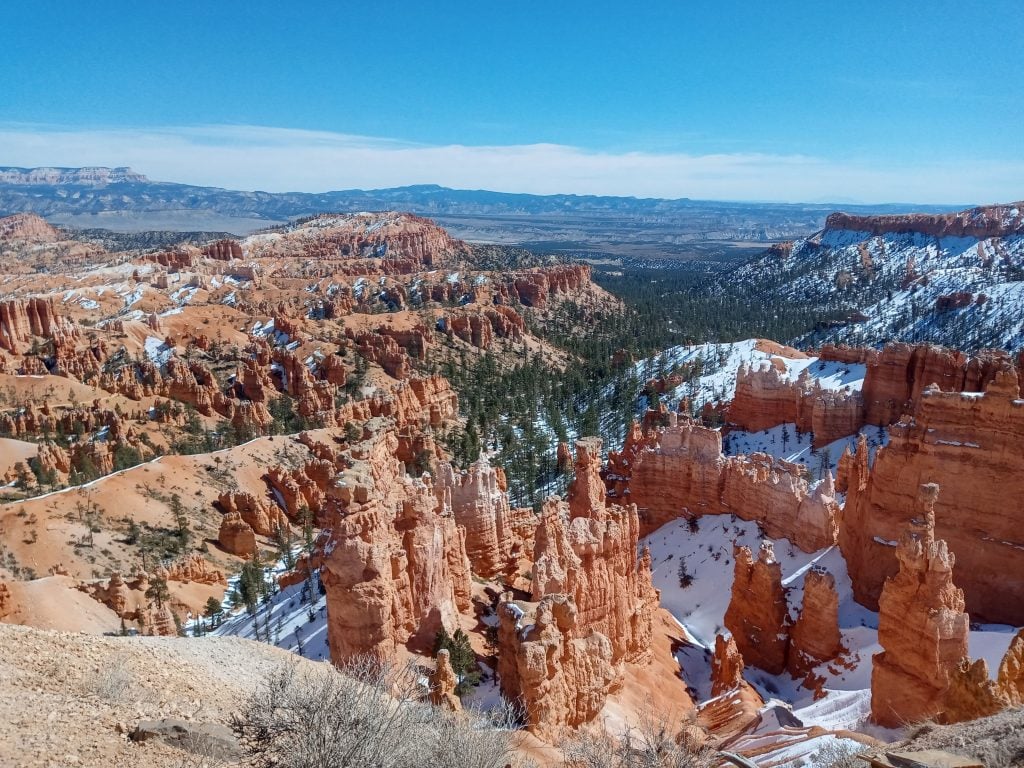
- Bryce Canyon. Photo by author (Nikki Cleveland)
Capitol Reef National Park
Capitol Reef is perhaps Utah’s most underrated National Park. The park is only about 2.5 hours east of Bryce Canyon via the Scenic Byway 12. Much like Zion, the landscape is centered around massive red rock cliffs.
There is only one developed campground in Capitol Reef and it is open year round: Fruita Campground accepts reservations during the peak season March 1–October 31st. The campground has spacious sites for all types of campers as well as a dump station and potable water. The area is very remote with no cell service, so come prepared and be ready to unplug.
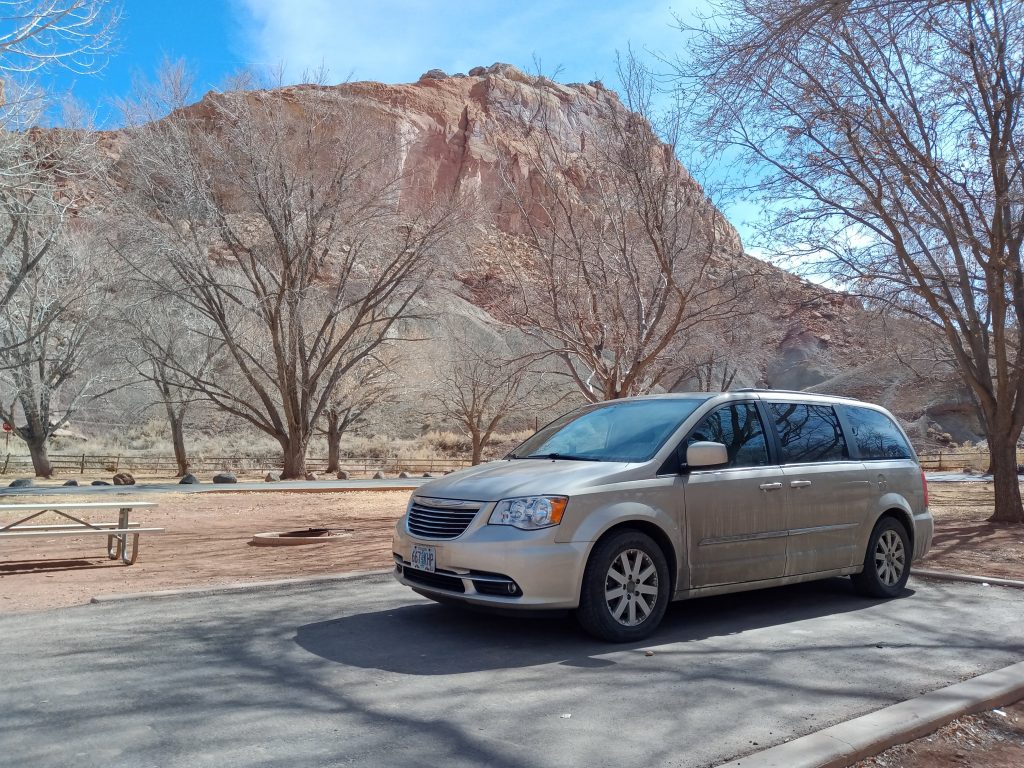
- Camping in Utah at Capitol Reef National Park. Photo by author (Nikki Cleveland)
Arches National Park
Arches National Park is not only the most iconic park in Utah, but one of the most famous national parks in the country. According to the NPS, Arches National Park sees around 1.5 million visitors a year. Because of this, the park can have significant delays at the entrance, and often fills all the way up during the busy months. Plan your visit early, on a weekday, or during the off-season to ensure that you’ll be able to get in to the park.
However, the park draws in crowds for good reason. The natural arches and giant rock formations provide some pretty amazing views. Stop by the viewpoint overlooking the famous Delicate Arch or take the 3-mile hike to see the arch up close.
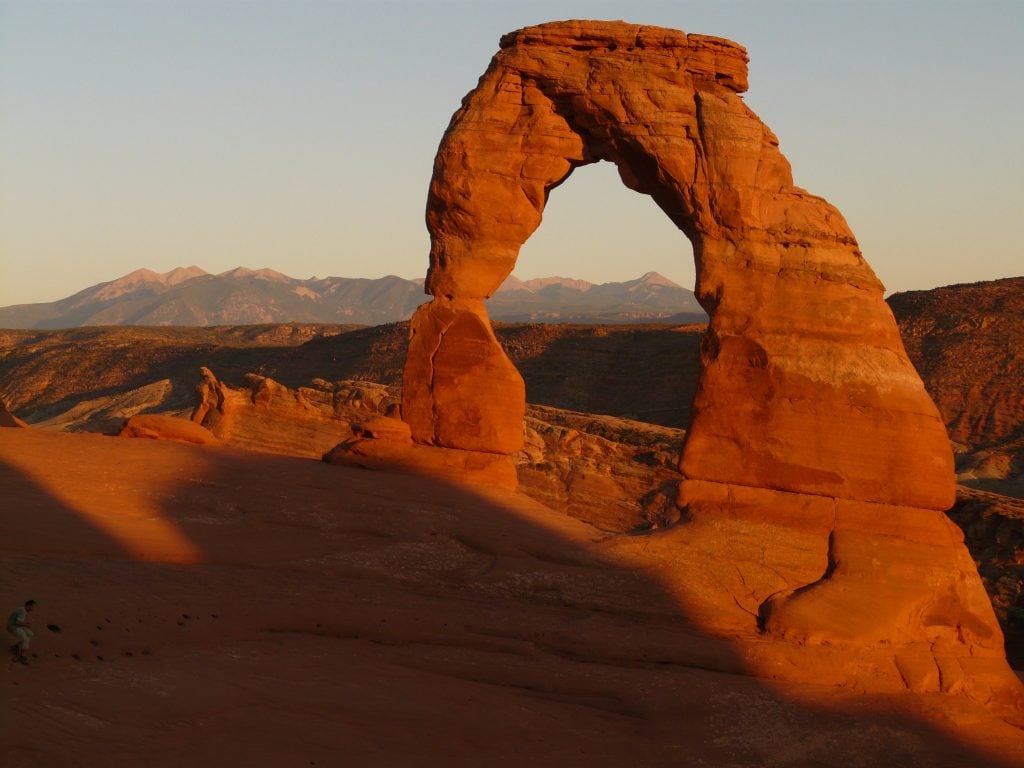
- Delicate Arch. Photo by Pxhere
There is only one campground located in the park: Devils Garden Campground. Due to the park’s popularity, reservations are essential if you want a spot. There are several more campgrounds in the area, as well as acres of BLM land for boondocking, that are just a short drive from the park entrance.
Canyonlands National Park
Canyonlands National Park is about an hour’s drive from Moab. The park is divided into four different districts; the Island In The Sky District is the most popular and the easiest to access. The Needles District is located in the southeastern part of the park with scenic hiking trails, a campground, and a visitor center.
The Maze is the most remote district in the park. Those visiting the Maze will need to be completely self-sufficient as there are no services available. Lastly, the Rivers District provides access to the Colorado and Green Rivers, which carve the park’s massive canyons.
One of the best known highlights in the park is the Mesa Arch. This iconic rock formation is located in the Island In The Sky District just off Grand View Point Road. The arch is very easy to access from the trailhead at just a half-mile walk with minimal elevation gain.
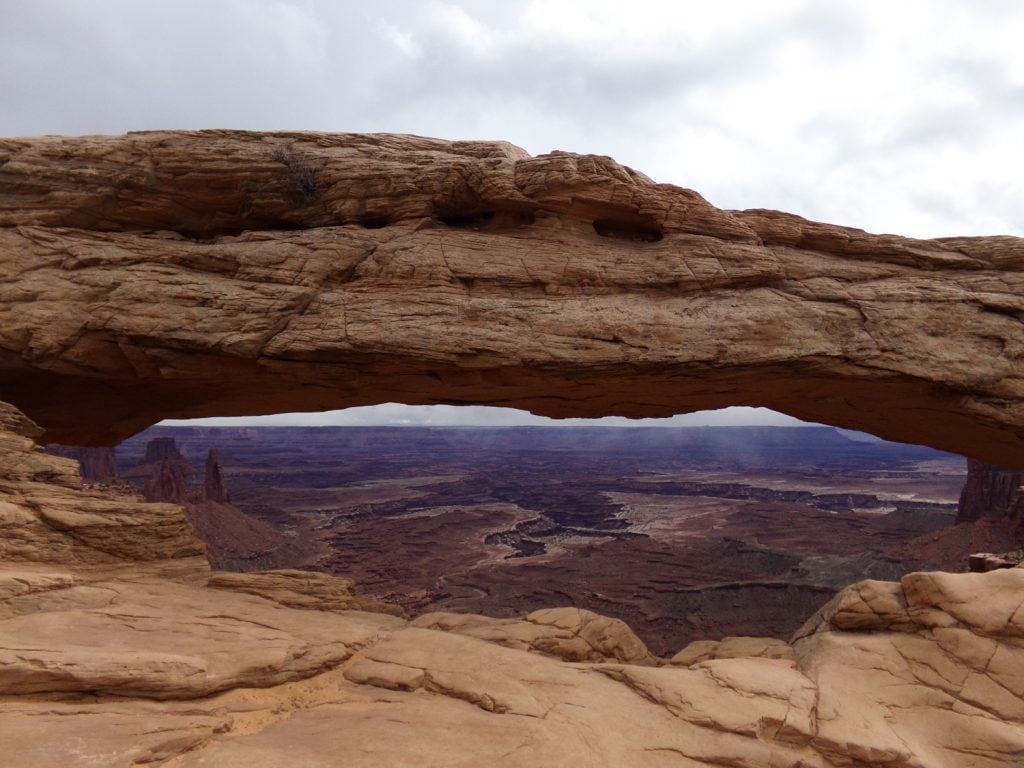
- Mesa Arch in Canyonlands National Park. Photo by author (Nikki Cleveland)
Utah State Parks
While the “Mighty 5” National Parks get all the attention, there are several Utah State Parks with equally impressive views. Some notable parks include:
- Dead Horse Point State Park is just a short drive from Moab and Canyonlands National Park. The park also has an RV campground along with hiking trails and beautiful canyon views.
- Deer Creek State Park sits about an hour away from Salt Lake City on the shores of Deer Creek Reservoir. The park has great views of the Wasatch Mountains, a campground with waterfront sites, and opportunities for fishing and boating.
- Goblin Valley State Park, located about an hour from Capitol Reef, has hiking trails, unique rock formations, as well as an RV-friendly campground with about 23 sites.
- Jordanelle State Park makes a great home base just 40 minutes from SLC. The park is located on the shores of Jordanelle Reservoir and offers several activities like hiking, biking, swimming, boating, and fishing.
- Rockport State Park is also just 40 minutes away from SLC on the shores of Rockport Reservoir. The park has five developed campgrounds with both RV and tent sites available.
Camping Near Salt Lake City
There are several campgrounds and RV parks to choose from in the Salt Lake City area. A quick search on RV LIFE Campgrounds reveals there are 47+ RV campgrounds within a short drive of the city.
This includes a popular KOA Holiday, Pony Express RV Resort (a Sun RV Resorts location), nearby state parks, forest campgrounds, and private RV parks like the highly rated Mountain Valley RV Resort.
Camping on the Great Salt Lake
If you’re camping in Salt Lake City, you’ll be close to all kinds of attractions, restaurants, and businesses. However, if you want to camp even closer to the Great Salt Lake, there are a few state park campgrounds that will put you just a stone’s throw from the beach.
Antelope Island is the largest island on the Great Salt Lake. The island is preserved as a state park with a few RV-friendly campgrounds, beach access, and several hiking trails that overlook the lake. Read more about Antelope Island in our previous article here.
Great Salt Lake State Park also has a campground open year-round. The campground can accommodate RVs up to 40 feet in length. The sites include water and electricity and have access to the park’s dump station. The park additionally offers boat slips and public viewpoints overlooking the lake.
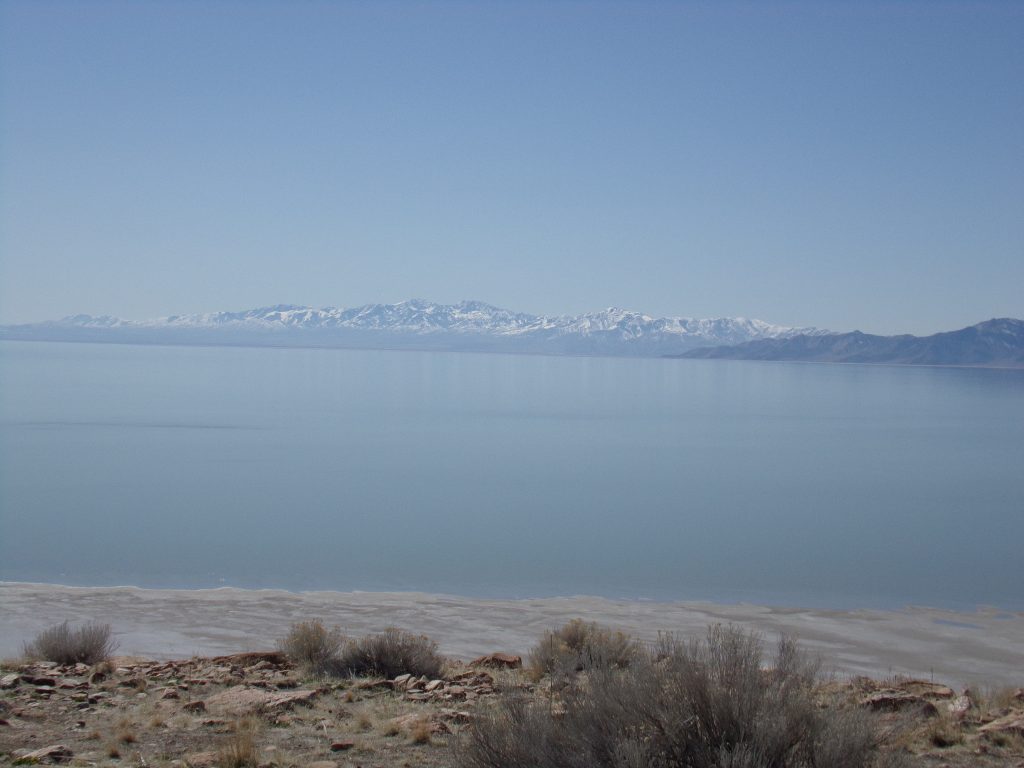
- Camping in Utah on Antelope Island. Photo by author (Nikki Cleveland)
Lake Powell camping
Lake Powell is located in Southern Utah and stretches into Northern Arizona. It is located in the Glen Canyon National Recreation Area as part of the Colorado River. There are several RV campgrounds in the area, including NPS-managed campgrounds and privately operated parks that provide spacious RV campsites and access to the river for activities.
Bullfrog RV & Campground is operated by Lake Powell Resorts & Marinas on the north end of Lake Powell. The campground has spacious tent & RV sites with full hookups and concrete pads. They have a camp store as well as a dump station, potable water, and a launch ramp.
Camping near Moab
Moab is a prime destination in Eastern Utah for outdoor enthusiasts, thanks to its close proximity to the iconic Arches National Park, Canyonlands National Park, and several other parks and trails.
The city has a wide variety of restaurants, guided tours are available, and there are plenty of RV camping accommodations to choose from. One of the best options in the area is Moab Valley RV Resort with spacious RV sites, tiny home rentals, and all the amenities needed for a comfortable stay.
Boondocking in Utah
Did you know that nearly 42% of Utah is public land? According to the BLM, the bureau manages over 22.9 million acres of public land in the state. This provides endless opportunities for RVers to go boondocking off the grid away from the crowded campgrounds.
Plan your Utah camping trip
Camping in Utah is a great adventure to experience in your RV. Be prepared with the RV LIFE Pro tools to get RV-safe GPS directions, campground reviews, and to find more points of interest — like fuel stations and dump stations — along the way. You may also want to check out our previous article on Camping In Nevada: An RVer’s Paradise Of Natural Wonders & Old West History.

Some of the best camping in the world is in UTAH. Arches, Bryce, Zion, and of course Capitol Reef and Canyonlands. Getting a campsite can be tough. I use “Campsite Notifier” from the App Store. It notifies you when a filled up campsite becomes available due to cancellations or any new openings. Works really well. Good luck out there and don’t forget the drive down through Grand Staircase Escalante.
We are planning a trip into the Utah area, to tour the Parks, would love more info on how best to tackle this trip from Louisiana. We drive a 25′ Tiffin Wafarer RV tow a Jeep. Advice solicited